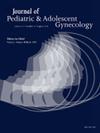30.。卵巢组织冷冻保存对肿瘤/自身免疫治疗时间的影响
IF 1.7
4区 医学
Q3 OBSTETRICS & GYNECOLOGY
引用次数: 0
摘要
背景:保留生育能力是年轻患者以及其他需要促性腺毒素治疗的医疗条件的综合癌症护理的一个组成部分。截至2019年,美国生殖医学学会(American Society for Reproductive Medicine)认为卵巢组织冷冻保存(OTC)不再是青春期前卵巢患者唯一的生育能力保存选择,也不再是标准的生育能力保存选择。尽管有这些建议,服务仍未得到充分利用。定性研究检查临床医生和患者感知障碍引用生育护理作为次要关注的潜在影响延迟紧急治疗。OTC可以快速进行,通常在转诊后5-7天内进行,包括腹腔镜单侧卵巢切除术,这已被证明对青春期前的青少年安全有效。我们的研究目的是评估非处方药是否会延迟患者的肿瘤或自身免疫治疗的开始时间。方法回顾性分析1999 - 2024年在同一所大学医院治疗的主要参保人群中因预期的促性腺毒素治疗而接受OTC治疗的58例患者。从预期开始日期到实际开始日期计算的治疗滞后时间与社会人口学变量(如非处方药时的种族和年龄)以及临床诊断一起测量。结果58例非处方药患者中,57例有可查记录。1例患者因未接受促性腺毒素治疗而被排除,共56例患者记录供复习。大多数患者为非拉丁裔白人,占51.7%(29/56)。OTC时的平均年龄为21岁,5个月至45岁不等。平均治疗滞后时间为0天,其中98.2%(55/56)患者无治疗延迟。根据进一步的图表评估,1名患者确实有延误,结果显示她的延误是由于高铁血镁蛋白血症,与她的OTC无关。结论:在我们的研究人群中,接受OTC治疗不会延迟肿瘤或自身免疫治疗的开始。在计划进行促性腺毒素治疗的患者中,OTC可以通过单侧卵巢切除术快速进行,对于保留未来生育能力和遗传亲子关系的可能性至关重要。本文章由计算机程序翻译,如有差异,请以英文原文为准。
30. Effect Of Ovarian Tissue Cryopreservation On Oncologic/Autoimmune Therapeutic Timeline
Background
Fertility preservation is an integral part of comprehensive cancer care for young patients as well as other medical conditions requiring gonadotoxic treatment. As of 2019, the American Society for Reproductive Medicine considers ovarian tissue cryopreservation (OTC), the only fertility preservation option for prepubertal patients with ovaries, no longer experimental and a standard fertility preservation option. Despite these recommendations, services remain underutilized. Qualitative studies examining clinician and patient perceived barriers have cited fertility care as a secondary concern with potential impacts on delaying urgent treatment. OTC can be performed quickly, often within 5-7 days of referral, involving laparoscopic unilateral oophorectomy, which has been shown to be safe and effective in prepubertal youth. Our study aims to assess if performing OTC results in any delay in a patient's oncologic or autoimmune therapy start time.
Methods
A retrospective chart review of 58 patients who had undergone OTC due to anticipated gonadotoxic therapy from 1999 - 2024 in a single university hospital setting treating a primarily insured population. Treatment lag time, calculated from date of expected start date to actual start date was measured along with sociodemographic variables such as ethnicity and age at the time of OTC as well as clinical diagnosis.
Results
Out 58 patients who had undergone OTC, 57 patients had records available to review. 1 patient was excluded as she had no gonadotoxic treatment, yielding 56 patient records for review. The majority of the patients identified as non-Latine white at 51.7% (29/56). Mean age at the time of OTC was 21 years old, ranging from 5 months to 45 years. Mean treatment lag time was 0 days, where 98.2% (55/56) of patients had no treatment delay. The 1 patient who did have a delay, upon further chart evaluation revealed that her delay in care was due to methemaglobinemia, unrelated to her OTC.
Conclusions
In our study population, undergoing OTC did not delay initiation oncologic or autoimmune therapy. OTC can be performed quickly via unilateral oophorectomy in patients with planned gonadotoxic therapy and is crucial to preserve future fertility for the possibility of genetic parenthood.
求助全文
通过发布文献求助,成功后即可免费获取论文全文。
去求助
来源期刊
CiteScore
3.90
自引率
11.10%
发文量
251
审稿时长
57 days
期刊介绍:
Journal of Pediatric and Adolescent Gynecology includes all aspects of clinical and basic science research in pediatric and adolescent gynecology. The Journal draws on expertise from a variety of disciplines including pediatrics, obstetrics and gynecology, reproduction and gynecology, reproductive and pediatric endocrinology, genetics, and molecular biology.
The Journal of Pediatric and Adolescent Gynecology features original studies, review articles, book and literature reviews, letters to the editor, and communications in brief. It is an essential resource for the libraries of OB/GYN specialists, as well as pediatricians and primary care physicians.

 求助内容:
求助内容: 应助结果提醒方式:
应助结果提醒方式:


